|
Printables |
PowerPoints |
Online exercises |
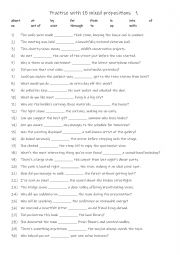
|
A1+-A2 Practise with 15 mixed prepositions 1
Mastering prepositions is vital for expressing relationships between ideas in English. They help indicate time, place, direction, and cause, making sentences more precise and meaningful. By practising with common prepositions like: about, at, by, for, from, in, into, of, on, out of, over, through, to, up, and with, students enhance their ability to...
Level: elementary
Age: 8-100
Type:
Downloads: 110
|
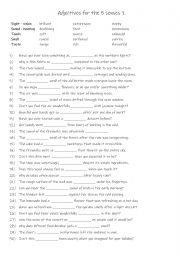
|
A2+-B1 15 adjectives for the 5 senses 1
Students should learn sensory adjectives to expand their descriptive vocabulary and enhance their communication skills. These words enable vivid and engaging descriptions, bringing writing and speech to life with clarity and detail. Adjectives like "picturesque," "deafening," or "tangy" help students express nuanced observations, while emotive term...
Level: elementary
Age: 8-100
Type:
Downloads: 110
|
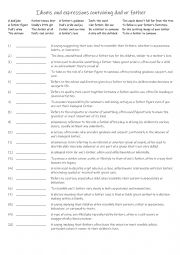
|
Idioms and expressions containing dad or father B1+-C1 (1)
Learning phrases about fathers improves cultural literacy, communication, and creativity in language use. Expressions like "Like father, like son" and "The apple doesn�t fall far from the tree" help students understand societal views on family and inheritance. Figurative phrases like "Dad�s taxi service" or "A father�s love" add depth and emotional...
Level: intermediate
Age: 10-100
Type:
Downloads: 110
|
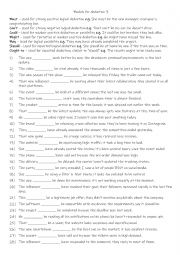
|
A2-B1 Modals for deduction 3
First, students need to familiarise themselves with the modals and their use. Then they read the sentences to see which one is needed to complete the gap-fill. Each modal is used 4 times! Answers on page 2.
Level: intermediate
Age: 9-100
Type:
Downloads: 110
|
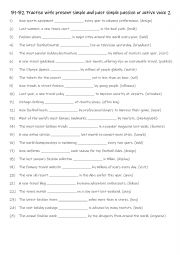
|
B1-B2 Practise with present simple and past simple passive or active voice 2
Understanding both voices help students become more versatile in expressing ideas, improving their ability to describe events and actions in the present and past from different perspectives. First, students need to familiarise themselves with the 2 tenses using both the active & passive voice. Then they read the sentences to see which one is needed...
Level: intermediate
Age: 10-100
Type:
Downloads: 110
|
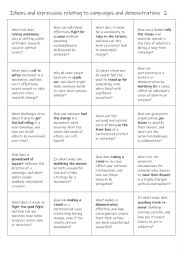
|
B1+-C1 Idioms and Expressions Relating to Campaigns and Demonstrations 2
This is a speaking reinforcement activity to supplement the other worksheet I uploaded on13/2/2025. Students working in pairs or small groups can either ask each other the questions or answer the question themselves.
Level: intermediate
Age: 12-100
Type:
Downloads: 110
|

|
B1+-C1 Idioms and expressions relating to bans and prohibitions 2
This is a speaking reinforcement activity to supplement the other worksheet I uploaded on 10/2/2025. Students working in pairs or small groups can either ask each other the questions or answer the question themselves.
Level: intermediate
Age: 12-100
Type:
Downloads: 110
|
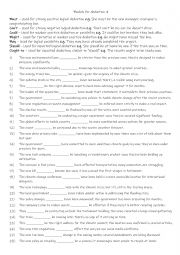
|
A2-B1 Modals for deduction 4
First, students need to familiarise themselves with the modals and their use. Then they read the sentences to see which one is needed to complete the gap-fill. Each modal is used 4 times! Answers on page 2
Level: elementary
Age: 9-100
Type:
Downloads: 110
|
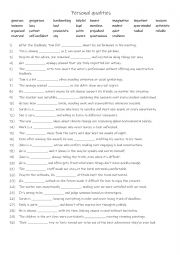
|
B1-B2 30 adjectives for personal qualities
First, students need to familiarise themselves with the 30 adjectives and their meanings. Then they read the sentences to see which one is needed to complete the gap-fill. Answers on page 2.
Level: intermediate
Age: 11-100
Type:
Downloads: 110
|
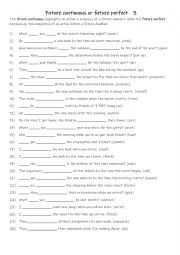
|
A2+-B1 Future continuous or future perfect 3
Understanding these tenses allows students to communicate future goals, schedules, and timelines effectively, enhancing both their speaking and writing skills for academic, professional, and everyday use. First, students need to familiarise themselves with the 2 tenses and their use. Then they read the sentences to work out which tense is needed to...
Level: elementary
Age: 10-100
Type:
Downloads: 110
|
|
|
|
|












